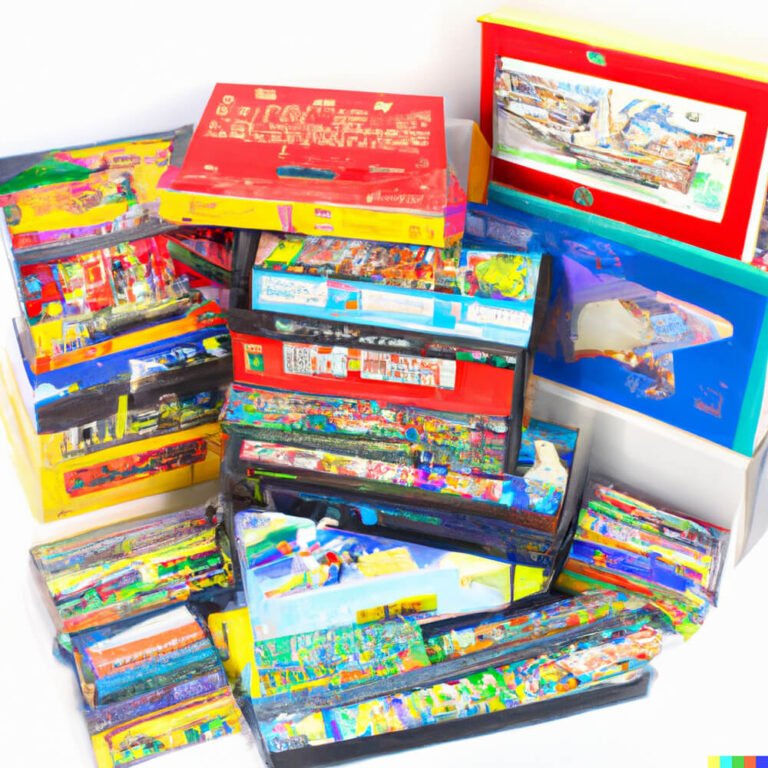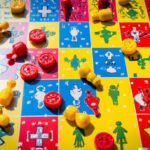Classic Kids Board Games have stood the test of time, capturing the hearts and minds of children for generations.
From iconic games like Monopoly and Scrabble to lesser-known gems, these tabletop delights bring immense joy and valuable learning experiences to kids of all ages. The enchanting allure of classic board games lies in their ability to engage young minds in strategic thinking, problem-solving, and social interaction.
In this article, we will delve into the world of these beloved games, uncovering why they matter so much for child development and family bonding. We will also explore the top 10 most popular classic kids board games of all time, taking a walk down memory lane as we reminisce about hours spent huddled around game boards with friends and family.
Furthermore, we’ll take a journey through the evolution of classic kids board games, examining how they have transitioned from their traditional forms to embrace modern twists. We’ll also provide valuable tips on how to choose the perfect game for your child’s age and interests.
So grab a cup of hot cocoa, gather around a cozy table with loved ones, and prepare to embark on an odyssey filled with laughter, competition, and cherished memories as we explore the timeless charm and educational value of classic kids board games. Don’t miss out on our bonus sections that discuss fun DIY variations and customizations for these games or how they are adapting to the digital age. Let’s dive in.
Why Classic Kids Board Games Matter
Social and Emotional Development
Classic kids board games provide numerous benefits for child development, especially in terms of social and emotional growth. Playing these games encourages children to engage in conversations, take turns, and practice good sportsmanship. They learn how to follow rules, negotiate with others, and cope with both winning and losing. These experiences help children develop important social skills such as communication, cooperation, and empathy.
Moreover, classic kids board games offer a unique opportunity for family bonding. When families come together to play these games, they create lasting memories and strengthen their relationships. Playing board games allows family members to connect on a deeper level by sharing laughter, friendly competition, and quality time. It provides a safe and enjoyable environment for everyone to interact and enjoy each other’s company.
Cognitive Development
In addition to promoting social skills, classic kids board games also support cognitive development in children. These games require critical thinking skills as players strategize their moves or solve problems presented throughout the game. They enhance logical reasoning abilities as well as decision-making skills. Kids have to think ahead, plan their actions, and anticipate their opponents’ moves.
Furthermore, classic kids board games stimulate the development of various cognitive skills such as memory retention, pattern recognition, attention span, and concentration. Children need to remember the rules of the game or specific actions they need to take during their turn. They also learn to recognize visual patterns on game boards or cards and use their observational skills effectively.
Academic Benefits
Classic kids board games can have academic benefits too. Many of these games involve counting spaces or points along the way while moving pieces around the game board. This helps children practice basic math skills such as addition or subtraction in a fun and engaging way. Additionally, some classic kids board games involve reading instructions or cards out loud which contributes to improving literacy skills.
Moreover, these games often require problem-solving and critical thinking skills, which are essential for academic success in subjects like math and science. Playing classic board games can develop a child’s ability to analyze situations, think creatively, and find solutions to challenges presented in the game. This transferable skill set can be useful in various academic settings.
Overall, classic kids board games play a crucial role in promoting child development and fostering family bonding. These games offer numerous benefits for children, including social and emotional growth, cognitive development, and even academic advantages. By incorporating these games into children’s lives, parents and educators can create a nurturing environment where children learn while having fun with their loved ones.
Top 10 Most Popular Classic Kids Board Games of All Time
Classic kids board games have been a staple in households for generations, providing hours of entertainment and fostering valuable skills in children. From strategic thinking to social interaction, these games offer numerous benefits for child development and family bonding. In this section, we will explore the top 10 most popular classic kids board games of all time.
1. Monopoly: This iconic game has been captivating players since its release in 1935. It teaches children important lessons about money management, negotiation skills, and decision-making.
2. Scrabble: Scrabble challenges kids to expand their vocabulary and improve their spelling abilities. It promotes strategic thinking and encourages friendly competition among players.
3. Candy Land: Designed for younger children, Candy Land is a colorful and imaginative game that teaches them how to follow instructions, take turns, and develop patience.
4. Chutes and Ladders: A game of luck and chance, Chutes and Ladders helps young children learn basic counting skills while also teaching them valuable life lessons about consequences and actions.
5. Clue: Known as the classic “whodunit” mystery game, Clue requires deductive reasoning as players try to solve the murder of Mr. Boddy. It enhances critical thinking skills and encourages logical reasoning.
6. Operation: This fun-filled game challenges children’s hand-eye coordination as they attempt to remove various ailments from “Cavity Sam” without setting off the buzzer. It promotes fine motor skills and concentration.
7. Sorry.: Sorry. is a fast-paced game that teaches kids to strategize while also teaching them good sportsmanship by apologizing when necessary. It reinforces the concept of empathy by encouraging players to understand others’ feelings when they get bumped back.
8. Trouble: With its iconic Pop-O-Matic dice roller, Trouble is a simple but addictive game that helps young children develop essential counting skills while also teaching them how to handle setbacks with resilience.
9. Connect Four: This classic game of strategy requires players to outsmart their opponents by forming a row of four discs in a horizontal, vertical, or diagonal line. It helps improve logical thinking and planning ahead.
10. Battleship: Players use critical thinking and deduction skills to strategically place their ships and sink the opponent’s fleet. Battleship enhances problem-solving abilities and spatial reasoning.
These top 10 classic kids board games have stood the test of time due to their engaging gameplay, educational value, and fun-factor. Introducing children to these beloved games can create lasting memories while also providing them with important life skills.
The Evolution of Classic Kids Board Games
Classic kids board games have come a long way since their inception. Over the years, these games have evolved and adapted to fit the changing interests and preferences of children. While the basic concept of board games remains the same – rolling dice, moving pieces, and achieving a goal – modern twists and innovations have added excitement and creativity to the traditional gameplay.
One major aspect of the evolution of classic kids board games is the introduction of themed versions. Many popular board games have been given a modern twist by incorporating characters from movies, TV shows, and video games that are popular among children.
For example, Monopoly now has various versions featuring different themes such as Disney characters or city landmarks. These themed versions not only make the games more appealing to kids but also create a sense of familiarity with characters they already love.
Another significant development in classic kids board games is digital integration. With the advancement of technology, many classic board games can now be played online or through mobile apps. This allows children to enjoy their favorite board game anytime and anywhere without needing physical game boards or pieces. Digital adaptations often offer additional features such as interactive animations, sound effects, and multiplayer options, enhancing the overall gaming experience for kids.
Furthermore, some classic kids board games have undergone rule changes or modifications to make them more engaging in today’s fast-paced world. For instance, traditional card matching games like Memory have been transformed into quicker versions with addictive gameplay mechanics to capture children’s attention span better. These changes aim to cater to the shorter attention spans and instant gratification that are common in our digital age.
| Classic Kids Board Game | Modern Twist or Innovation |
|---|---|
| Monopoly | Themed versions featuring popular characters or landmarks |
| Memory | Quicker versions with addictive gameplay mechanics |
| Candy Land | Digital versions with interactive animations |
How to Choose the Perfect Classic Kids Board Game for Your Child’s Age and Interest
When it comes to choosing the perfect classic kids board game for your child’s age and interest, there are a few factors to consider. Board games offer a great opportunity for children to develop various skills such as critical thinking, problem-solving, and decision-making. They also provide a chance for family bonding and quality time together. Here are some helpful tips on how to choose the best game for your child:
1. Consider their age: Different board games are designed for specific age groups. Younger children may enjoy simple games that focus on colors, shapes, and counting, while older children can handle more complex games with strategic elements. Look for age recommendations on the box or read reviews online to get an idea of the appropriate age range.
2. Pay attention to their interests: To keep your child engaged, consider their current interests and hobbies. Are they into animals? Science? Fairy tales? There is a board game out there for almost every interest. Look for themes that align with what your child enjoys to ensure they will be excited about playing.
3. Assess the complexity level: Classic kids board games vary in complexity levels, so it’s important to choose one that matches your child’s skill level. Some children may thrive with more challenging games that require advanced thinking skills, while others may prefer simpler games with easy-to-understand rules. Take into account your child’s abilities and preferences when selecting a game.
Once you’ve chosen a game that suits your child’s age and interest, encourage them to take an active role in learning and playing it. Guide them through the rules and gameplay initially, but as they become more familiar with the game, allow them to make decisions independently and develop their own strategies.
By choosing the right classic kids board game tailored specifically to your child’s needs, you can provide them with hours of fun while enhancing their cognitive abilities at the same time.
Tips for Hosting a Classic Kids Board Game Night
Hosting a classic kids board game night can be a fun and memorable experience for the entire family. It’s a great opportunity to bond, create lasting memories, and enjoy some quality time together. Here are some tips to help you host a successful board game night that will be cherished by both children and adults alike.
1. Choose the Right Games: When hosting a classic kids board game night, it is essential to choose games that are suitable for the age group of the children participating. Consider games that are easy to understand and play, with simple rules and mechanics. Some popular choices include Candy Land, Chutes and Ladders, and Uno.
2. Set the Mood: Create a cozy and inviting atmosphere for your board game night. Arrange comfortable seating in a well-lit area, preferably away from distractions such as TVs or other electronic devices. You could even dim the lights or light some candles to add to the ambiance.
3. Snacks and Refreshments: No game night is complete without snacks. Prepare some finger foods like popcorn, pretzels, or mini sandwiches for everyone to munch on while playing. Don’t forget to have beverages available too – juice boxes for the little ones and perhaps soda or water for the older players.
To make your game night even more exciting, consider adding some playful twists along the way. For example, award small prizes or stickers to winners of each game played or create custom-made scorecards to keep track of scores throughout the evening.
Hosting a classic kids board game night is not only about having fun but also about creating lasting memories with our loved ones. It allows us to disconnect from technology and spend quality time together engaging in friendly competition and laughter. So gather your family and friends, pick some fantastic games, and get ready for an evening filled with joy, laughter, and endless memories.
Fun DIY Game Variations and Customizations for Classic Kids Board Games
Classic kids board games have been enjoyed by families for generations, and one of the most exciting aspects is the opportunity to create your own game variations and customizations. This not only adds a unique twist to the gameplay, but also encourages creativity and critical thinking in children. Here are some fun DIY game variations and customizations that can breathe new life into classic kids board games.
Theme-Based Variations
One way to bring a fresh perspective to classic kids board games is by incorporating a theme into the gameplay. For example, you can transform the traditional game of Monopoly into a Disney-themed adventure where players buy and trade iconic Disney properties instead of regular properties on the board. By selecting a theme that resonates with your child’s interests, you can make the game more engaging and enjoyable.
Rule Modifications
Another fun way to customize classic kids board games is by tweaking the rules. Depending on your child’s age and skill level, you can simplify or add complexity to certain rules to make the game more challenging or accessible. For instance, in chess, you may introduce a rule where each player gets an additional special move once per game, adding an element of surprise and strategy.
Personalized Game Assets
Adding personalized touches to classic kids board games can add excitement and make them feel more special. Involve your child in creating their own game pieces, designing unique cards, or even crafting a customized game board. These small details not only enhance creativity but also foster ownership and pride in playing the game.
By allowing children to explore their imagination through DIY variations and customizations, they develop problem-solving skills, critical thinking abilities, and social interaction capabilities. Moreover, it transforms family game nights into memorable experiences that create lasting bonds between family members. So unleash your creativity with these fun DIY ideas for classic kids board games.
Classic Kids Board Games in the Digital Age
With the rapid advancement of technology, traditional classic kids board games have also found their place in the digital age. Online versions and apps of these games have become increasingly popular, offering a new way for children to engage with their favorite board games. This section will explore the world of classic kids board games in the digital age, discussing the benefits and potential drawbacks of playing these games online.
One of the major advantages of online versions and apps is the convenience and accessibility they offer. Children can now play their favorite classic kids board games anytime, anywhere, without needing to set up a physical game board or gather players.
This is especially beneficial for families who may not have enough space in their homes for multiple game sets or for those who are constantly on the go. Additionally, online versions often come with interactive features and animations that add an extra level of excitement to gameplay.
However, it is important to acknowledge that there are potential drawbacks to playing classic kids board games in the digital realm. Many traditional board games foster face-to-face interaction and encourage social skills development through communication, negotiation, and problem-solving with fellow players.
While online versions may still provide opportunities for interaction through chat functions or multiplayer modes, they cannot fully replicate the same level of personal connection as sitting around a physical game board. It is also worth considering screen time limits and ensuring that children are engaging in a healthy balance of offline and online activities.
Introducing Classic Kids Board Games to a New Generation
Kids today are growing up in the digital age, surrounded by screens and technology. However, it is important not to forget the timeless charm and educational value of classic kids board games. Parents and educators can play a crucial role in introducing these traditional games to the new generation and ensuring that they continue to be enjoyed for years to come.
One tip for parents and educators when introducing classic kids board games to a new generation is to start with age-appropriate games. Younger children may enjoy simple games like Candyland or Chutes and Ladders, while older kids may be ready for more complex strategy games like Monopoly or Risk. By choosing games that align with a child’s age and interests, parents and educators can help foster engagement and enjoyment.
Another tip is to set aside dedicated time for board game play. In our busy lives, it can be easy to overlook the importance of quality family time.
By incorporating classic board game nights into our routines, we not only teach children valuable social skills like turn-taking and problem-solving but also create cherished memories that will last a lifetime. Whether it’s a weekly family game night or a special event with classmates or friends, these shared experiences can strengthen relationships and build connections.
Lastly, parents and educators should embrace the opportunity for learning during board game play. Classic kids board games offer numerous educational benefits such as enhancing critical thinking skills, promoting logical reasoning, improving communication abilities, and fostering sportsmanship. Parents can engage in discussions during gameplay about strategy, decision-making processes, or even historical context if relevant to the game being played. Educators can incorporate classic kids board games into their lesson plans as fun ways of reinforcing concepts taught in class.
Introducing classic kids board games to a new generation requires effort from parents and educators alike. By selecting age-appropriate games, setting aside dedicated time for play, and embracing the educational opportunities presented by these games, we can ensure that this beloved form of entertainment and learning continues to be passed down through the generations.
Conclusion
In conclusion, classic kids board games hold a timeless charm and are rich in educational value. From promoting child development to fostering family bonding, these games have stood the test of time for good reason. Despite the evolution of modern technology and digital alternatives, the appeal of classic kids board games remains strong.
These traditional games have been shown to offer numerous benefits for child development. They enhance critical thinking skills, strategic planning, decision-making abilities, and problem-solving capabilities. By engaging in gameplay, children also develop social skills such as turn-taking, teamwork, and communication. Moreover, classic kids board games help stimulate creativity and imagination as players immerse themselves in different worlds and scenarios.
Beyond their educational value, classic kids board games also provide a unique opportunity for families to bond and create lasting memories together. Gathering around a table for game night fosters quality time spent with loved ones without distractions from screens or devices. The laughter and friendly competition that arise during gameplay create a positive environment conducive to building relationships and nurturing connections among family members.
As we navigate the digital age, it is important not to overlook the enduring charm of classic kids board games. While online versions and apps may offer convenience and accessibility, they cannot fully replicate the tangible experience provided by physical game boards and pieces. To introduce classic kids board games to a new generation, parents and educators can emphasize their educational value while highlighting the fun and social aspects they bring to the table.

I love playing all kinds of games – from classics like Monopoly to modern favourites like Ticket to Ride.
I created this blog as a way to share my love of board games with others, and provide information on the latest releases and news in the industry.





